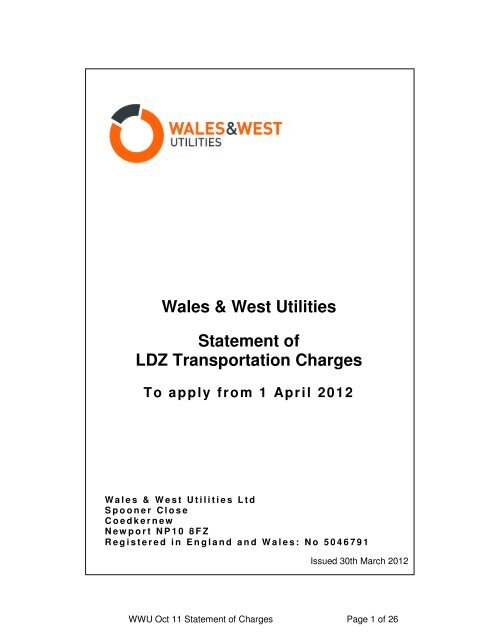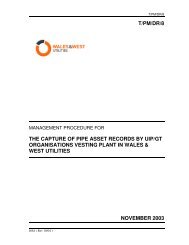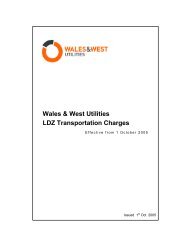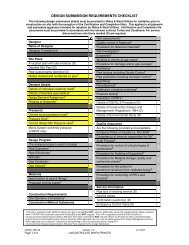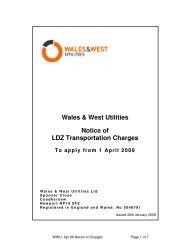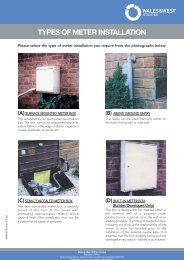WWU Statement of LDZ Transportation Charges to ... - Our Home Page
WWU Statement of LDZ Transportation Charges to ... - Our Home Page
WWU Statement of LDZ Transportation Charges to ... - Our Home Page
You also want an ePaper? Increase the reach of your titles
YUMPU automatically turns print PDFs into web optimized ePapers that Google loves.
Wales & West Utilities<strong>Statement</strong> <strong>of</strong><strong>LDZ</strong> <strong>Transportation</strong> <strong>Charges</strong>To apply from 1 April 2012W a l e s & W e s t U t i l i t i e s L t dS p o o n e r C l o s eC o e d k e r n e wN e w p o r t N P 1 0 8 F ZR e g i s t e r e d i n E n g l a n d a n d W a l e s : N o 5 0 4 6 7 9 1Issued 30th March 2012<strong>WWU</strong> Oct 11 <strong>Statement</strong> <strong>of</strong> <strong>Charges</strong> <strong>Page</strong> 1 <strong>of</strong> 26
CONTENTS1. <strong>LDZ</strong> TRANSPORTATION CHARGES TO APPLY FROM 1 st APRIL 20121.1 Introduction 31.2 <strong>LDZ</strong> System <strong>Charges</strong> 41.3 <strong>LDZ</strong> Cus<strong>to</strong>mer <strong>Charges</strong> 61.4 Other <strong>Charges</strong> 71.5 Examples 82. APPENDICESAPPENDIX 2A 113. APPLICATION OF THE <strong>LDZ</strong> CHARGES METHODOLOGY3.1 Introduction 153.2 System <strong>Charges</strong> Methodology 173.3 <strong>LDZ</strong> and Other <strong>Charges</strong> Methodology 22<strong>WWU</strong> Oct 11 <strong>Statement</strong> <strong>of</strong> <strong>Charges</strong> <strong>Page</strong> 2 <strong>of</strong> 26
<strong>LDZ</strong> TRANSPORTATION CHARGES TO APPLY FROM 1 APRIL 20121.1. IntroductionThis publication sets out the <strong>LDZ</strong> transportation charges which will apply from 1 April 2012 for the use <strong>of</strong> theWales & West Distribution Network (DN), as required by Standard Special Condition A4 <strong>of</strong> the GasTransporter Licence. This document does not override or vary any <strong>of</strong> the statu<strong>to</strong>ry, licence or UniformNetwork Code obligations upon Wales & West Utilities.For more information on the charges set out below, contact the Transporter’s Pricing team on 02920 278838.1.1.1. Uniform Network CodeThe Uniform Network Code is supported by an integrated set <strong>of</strong> computer systems called UK Link. Thecharges and formulae in this booklet will be used in the calculation <strong>of</strong> charges within UK Link, which aredefinitive for billing purposes.There are a number <strong>of</strong> areas <strong>of</strong> the Uniform Network Code that impact upon the cost <strong>to</strong> Shippers <strong>of</strong> using thetransportation network, such as imbalance charges, scheduling charges, capacity over-runs and ratchets,<strong>to</strong>p-up neutrality charges and contractual liability. The Uniform Network Code and related documents can befound on the Joint Office <strong>of</strong> Gas Transporters website (www.gasgovernance.co.uk)1.1.2. UnitsCommodity charges are expressed and billed in pence per kilowatt hour (kWh).Capacity charges are expressed and billed in pence per peak day kilowatt hour per day.Fixed charges are expressed and billed in pence per day.1.1.3. InvoicingThe Xoserve Invoicing team produce and issue the invoices that are derived from the transportation chargesshown within this publication. To clarify this link between pricing and invoicing, charge codes and invoicenames are included in the tables.For more information on invoicing, please contact Xoserve, the invoicing service provider, via e-mail atcss.billing@xoserve.com.1.1.4. The distribution price control formulaDistribution charges are derived in relation <strong>to</strong> a price control formula set by Ofgem, the gas and electricitymarket regula<strong>to</strong>r, for the transportation <strong>of</strong> gas. This formula dictates the maximum revenue that can beearned from the transportation <strong>of</strong> gas. Should the DN opera<strong>to</strong>r earn more or less than the maximumpermitted revenue in any formula year, a compensating adjustment is made in the following year. Under therevised Licences the normal date for changing any <strong>of</strong> the charges will be 1 April.Within the Network price control revenue recovery is split between <strong>LDZ</strong> system charges and <strong>LDZ</strong> cus<strong>to</strong>mercharges. The relative level <strong>of</strong> these charges is based on the relative level <strong>of</strong> costs <strong>of</strong> these areas <strong>of</strong> activity.1.1.5. Firm transportationAll Network transportation charges are based on Firm supply only and comprise <strong>LDZ</strong> capacity andcommodity charges plus <strong>LDZ</strong> cus<strong>to</strong>mer charges.1.1.6 Theft <strong>of</strong> gasThe licensing regime places incentives on Transporters, Shippers and Suppliers <strong>to</strong> take action in respect <strong>of</strong>suspected theft <strong>of</strong> gas. Certain costs associated with individual cases <strong>of</strong> theft are recovered through<strong>WWU</strong> Oct 11 <strong>Statement</strong> <strong>of</strong> <strong>Charges</strong> <strong>Page</strong> 3 <strong>of</strong> 26
transportation charges. The charges reflect these requirements, with the Transporter remaining cash neutralin the process.1.1.8 Isolations and DisconnectionsWhere a shipper has left a Supply Meter physically connected <strong>to</strong> the Transporter's network following a UNCIsolation and Withdrawal, 12 months after the effective Withdrawal, the Transporter must take action <strong>to</strong>disable the flow <strong>of</strong> gas where the shipper has not undertaken a physical disconnection <strong>of</strong> the meter. TheTransporter is permitted <strong>to</strong> pass the costs incurred in undertaking the work <strong>to</strong> the last Registered User. TheTransporter will calculate the charge <strong>to</strong> the shipper on a fully absorbed time and materials basis, consistentwith the charging principles set out in the Transporter's Connections Charging Methodology <strong>Statement</strong>.1.1.9. Relationship <strong>of</strong> <strong>Charges</strong> <strong>to</strong> Price Control Maximum Allowed RevenueFollowing determination <strong>of</strong> the price control for Formula Years 2008/9 <strong>to</strong> 2012/13, it was estimated that theMaximum Allowed Revenue (MAR) for Wales & West Network for 2012/13 is £353.3m.The transportation charges in place prior <strong>to</strong> April 2012 were estimated <strong>to</strong> recover £336.6m for FY 2012/13.Inorder <strong>to</strong> bring charges in<strong>to</strong> line with the Maximum Allowed Revenue, charges were increased by 5.0% from1 st April 2012. The increase <strong>of</strong> 5.0% allows for a reduction <strong>of</strong> 3.0% in capacity income between 1 st Oc<strong>to</strong>ber2012 and 31 st March 2013 resulting from an expected fall in SOQs following the AQ review effective from 1 stOc<strong>to</strong>ber 2012. Forecast under/over recovery (K) against MAR at 31st March 2013 is estimated <strong>to</strong> be zero.From 1st April 2012, the distribution transportation charges in respect <strong>of</strong> a typical domestic load consuming16,000 kWh/annum, was estimated <strong>to</strong> be £140.16 per annum excl. VAT.1.2 <strong>LDZ</strong> System <strong>Charges</strong>The standard <strong>LDZ</strong> system charges comprise capacity and commodity charges, with separate functions fordirectly connected supply points and for Connected System Exit Points (CSEPs).Where the <strong>LDZ</strong> charges are based on functions, these functions use supply point Offtake Quantity (SOQ) inthe determination <strong>of</strong> the charges. At Daily Metered (DM) firm supply points the SOQ is the registered supplypoint capacity. For Non-Daily metered (NDM) supply points, the SOQ is calculated using the supply pointEnd User Category (EUC) and the appropriate load fac<strong>to</strong>r.1.2.1 Directly Connected Supply PointsThe unit charges and charging functions used <strong>to</strong> calculate charges <strong>to</strong> directly connected supply points areset out in Table 1.2.1 below.Table 1.2.1 Directly connected supply pointsInvoice Charge<strong>LDZ</strong> CapacityCode ZCA<strong>LDZ</strong> Commodity ZCO<strong>LDZ</strong> <strong>Charges</strong> Capacity CommodityPence per pk day kWh Pence Commodity per kWhUp <strong>to</strong> 73,200 kWh per annumper day Pence per Kwh0.1647 0.027273,200 <strong>to</strong> 732,000 kWh per annum 0.1429 0.0236732,000 kWh per annum and above 1.2793 x SOQ ^ -0.2513 0.2750 x SOQ ^ -0.2775Subject <strong>to</strong> a minimum rate <strong>of</strong> 0.0121 0.0019Minimum reached at SOQ <strong>of</strong> 107,786,664 58,320,905<strong>WWU</strong> Oct 11 <strong>Statement</strong> <strong>of</strong> <strong>Charges</strong> <strong>Page</strong> 4 <strong>of</strong> 26
1.2.2 Connected SystemsIn the calculation <strong>of</strong> the <strong>LDZ</strong> charges payable, the unit commodity and capacity charges are based on thesupply point capacity equal <strong>to</strong> the CSEP peak day load for the completed development irrespective <strong>of</strong> theactual stage <strong>of</strong> development. The SOQ used is therefore the estimated SOQ for the completed developmentas provided in the appropriate Network Exit Agreement (NExA). For any particular CSEP, each shipper willpay identical <strong>LDZ</strong> unit charges regardless <strong>of</strong> the proportion <strong>of</strong> gas shipped. Reference needs <strong>to</strong> be made <strong>to</strong>the relevant NExA or CSEP ancillary agreement <strong>to</strong> determine the completed supply point capacity.Table 1.2.2 Connected Systems (CSEPs)InvoiceCharge CodeADC Capacity 891ADCCommodity893ADC <strong>Charges</strong>CSEP CapacityCSEP CommodityUp <strong>to</strong> 73,200 kWh per annumPence per pk day kWh per0.1647 dayPence per kWhPence 0.0272 per Kwh73,200 <strong>to</strong> 732,000 kWh per annum 0.1429 0.0243 0.0236732,000 kWh per annum and above 1.2793 x SOQ ^ -0.2513 0.02260.2750 x SOQ ^ -0.2775Subject <strong>to</strong> a minimum rate <strong>of</strong> 0.0121 0.0019Minimum reached at SOQ <strong>of</strong> 107,786,664 58,320.9051.2.3 Optional <strong>LDZ</strong> ChargeThe optional <strong>LDZ</strong> tariff is available, as a single charge, as an alternative <strong>to</strong> the standard <strong>LDZ</strong> systemcharges. This tariff may be attractive <strong>to</strong> large loads located close <strong>to</strong> the NTS. The rationale for the optionaltariff is that, for large Network loads located close <strong>to</strong> the NTS or for potential new Network loads in a similarsituation, the standard <strong>LDZ</strong> tariff can appear <strong>to</strong> give perverse economic incentives for the construction <strong>of</strong>new pipelines when Network connections are already available. This could result in an inefficient outcomefor all system users.The charge is calculated using the function below:InvoiceCharge CodeADU 881Pence per peak day kWh per day902 x [(SOQ)^-0.834 ] x D + 772 x (SOQ) ^-0.717Where: (SOQ) is the Registered Supply Point Capacity, or other appropriate measure, in kWh per day and Dis the direct distance, in km, from the site boundary <strong>to</strong> the nearest point on the NTS. Note that ^ means “<strong>to</strong>the power <strong>of</strong>”. Further information on the optional tariff can be obtained from the Transporter’s Pricingteam on 02920 278838.<strong>WWU</strong> Oct 11 <strong>Statement</strong> <strong>of</strong> <strong>Charges</strong> <strong>Page</strong> 5 <strong>of</strong> 26
1.4 Other <strong>Charges</strong>Other <strong>Charges</strong> include administration charges at Connected System Exit Points, Shared Supply Meter Pointsand Interconnec<strong>to</strong>rs.1.4.1 Connected System Exit PointsA CSEP is a system point comprising one or more individual exit points which are not supply meter points.This includes connections <strong>to</strong> a pipeline system within the Wales & West Network but operated by a GasTransporter other than Wales & West UtilitiesThe calculation <strong>of</strong> <strong>LDZ</strong> charges payable for shipping <strong>to</strong> CSEPs is explained in section 1.2.2.There is no cus<strong>to</strong>mer charge payable for connected systems, however separate administration processesare required <strong>to</strong> manage the daily operations and invoicing associated with CSEPs, including interconnec<strong>to</strong>rs,for which an administration charge is made.The administration charge which applies <strong>to</strong> CSEPs containing NDM and DM sites is:CSEP administration chargeCharge persupply point0.1012 pence per day(£0.37 per annum)The invoice and charge codes are:Invoice Charge CodeDM CSEP ADU 883NDM CSEP ADC 8941.4.2 Shared supply meter point allocation arrangementsAn allocation service for daily metered supply points with AQs <strong>of</strong> more than 58,600 MWh per annum isavailable. This allows up <strong>to</strong> four (six for VLDMCs) shippers / suppliers <strong>to</strong> supply gas through a shared supplymeter point.The allocation <strong>of</strong> daily gas flows between the shippers / suppliers can be done either by an appointed agen<strong>to</strong>r by the transporter.The administration charges which relate <strong>to</strong> these arrangements are shown below. Individual chargesdepend on the type <strong>of</strong> allocation service nominated and whether the site is telemetered or non-telemetered.The charges are (expressed as £ per shipper per supply point) :InvoiceCharge CodeADU 883Agent ServiceTelemeteredNon-telemeteredSet-up charge £107.00 £183.00Shipper-shippertransfer charge£126.00 £210.00Daily charge £2.55 £2.96Transporter ServiceTelemeteredNon-telemeteredSet-up charge £107.00 £202.00Shipper-shippertransfer charge£126.00 £210.00Daily charge £2.55 £3.05<strong>WWU</strong> Oct 11 <strong>Statement</strong> <strong>of</strong> <strong>Charges</strong> <strong>Page</strong> 7 <strong>of</strong> 26
1.5 ExamplesNotes1. <strong>Charges</strong> produced by UK Link are definitive for charging purposes. Calculations below are subject <strong>to</strong>rounding and should be regarded as purely illustrative.2. The commodity charges in these examples are based on the supply point AQ, but the actual chargeswould vary depending on the actual consumption <strong>of</strong> the supply point.Example 1A shipper has a daily metered cus<strong>to</strong>mer in Cardiff, with an annual consumption (AQ) <strong>of</strong> 20,000,000 kWh anda registered supply point capacity (SOQ), booked directly by the shipper <strong>of</strong> 100,000 kWh per day.ProcessCalculations Used<strong>LDZ</strong> CapacityInvoice: <strong>LDZ</strong> Capacity (ZCA)See: Table 1.2.1Basis: p / peak day kWh / dayVolume: 365 days × 100,000 (SOQ) = 36,500,000Unit Rate: 1.2793 × 100,000 (SOQ) ^ -0.2513= 0.0709 p / pdkWh / dayAnnual Charge: Volume x Unit Rate = £25,787.50Plus<strong>LDZ</strong> CommodityInvoice: Commodity (ZCO)See: Table 1.2.1Basis: p / kWhVolume: 20,000,000 (AQ)Unit Rate: 0.275 × 100,000 (SOQ) ^ -0.2775= 0.0113p / kWhAnnual Charge: Volume x Unit Rate = £2,260.50PlusCus<strong>to</strong>mer (Capacity)Invoice: <strong>LDZ</strong> Capacity (CCA)See: Table 1.3.1Basis: p / peak day kWh / dayVolume: 365 days × 100,000 = 36,500,000Unit Rate: 0.0684 × 100,000(SOQ) ^ -0.2100= 0.0061p / pdkWh / dayAnnual Charge: Volume x Unit Rate = £2,226.50EqualsTotal Network ChargeTotal annual network charge = £30,365.00Unit Charge: Dividing by the annual load <strong>of</strong> 20,000,000 kWh gives a unit charge 0.1518 pence per kWh.<strong>WWU</strong> Oct 11 <strong>Statement</strong> <strong>of</strong> <strong>Charges</strong> <strong>Page</strong> 8 <strong>of</strong> 26
Example 2A shipper has a domestic cus<strong>to</strong>mer in Plymouth. Suppose the load has an AQ <strong>of</strong> 20,000 kWh per annum.Using the definition <strong>of</strong> end user categories table in Appendix 2A, this annual load places the end user incategory E0801B. Using the appropriate small NDM supply points table <strong>of</strong> load fac<strong>to</strong>rs, it can be seen thatthe load fac<strong>to</strong>r for such a site in the South West <strong>LDZ</strong> is 29.7%. The peak daily load (SOQ) is therefore20,000 ÷ (365 × 0.297) = 184 kWh.ProcessCalculations Used<strong>LDZ</strong> CapacityInvoice: <strong>LDZ</strong> Capacity (ZCA)See: Table 1.2.1Basis: p / peak day kWh / dayVolume: 365 days × 184 (SOQ) = 67,160Unit Rate: 0.1647 p / pdkWh / dayCharge: Volume x Unit Rate = £110.61Plus<strong>LDZ</strong> CommodityInvoice: Commodity (ZCO)See: Table 1.2.1Basis: p / kWhVolume: 20,000 (AQ)Unit Rate: 0.0272p / kWhCharge: Volume x Unit Rate = £5.44PlusCus<strong>to</strong>mer (Capacity)Invoice: Capacity (CCA)See: Table 1.3.1Basis: p / kWhVolume: 365 days x 184(SOQ) = 67,160Unit Rate: 0.0867 pdkWh / dayCharge: £58.23EqualssTotal Network ChargeTotal annual network charge = £174.28Unit Charge: Dividing by the annual load <strong>of</strong> 20,000 kWh gives a unit <strong>LDZ</strong> charge <strong>of</strong> 0.871 pence per kWh.<strong>WWU</strong> Oct 11 <strong>Statement</strong> <strong>of</strong> <strong>Charges</strong> <strong>Page</strong> 9 <strong>of</strong> 26
Example 3Suppose that instead <strong>of</strong> supplying just one domestic cus<strong>to</strong>mer in Plymouth (as in Example 2) the shipperactually supplies a connected system presently comprising 100 domestic cus<strong>to</strong>mers and the completedconnected system will comprise 150 domestic premises. Suppose that each <strong>of</strong> these premises has the same(AQ) <strong>of</strong> 20,000 kWh per annum.Prevailing AQ (pre AQ)Maximum AQ (max AQ)Prevailing SOQ (pre SOQ)Maximum SOQ (max SOQ)100 houses × 20,000 (AQ) = 2,000,000 kWh150 houses × 20,000 (AQ) = 3,000,000 kWh2,000,000 ÷ (365 × 0.297) = 18,449 kWh3,000,000 ÷ (365 × 0.297) = 27,674 kWhNote that the prevailing annual and peak day loads <strong>of</strong> the connected system in effect would change over theyear however, for simplicity, these have been assumed as constant in this example.ProcessCalculations Used<strong>LDZ</strong> CapacityInvoice: ADC (891)See: Table 1.2.2Basis: p / peak day kWh / dayVolume: 365 days × 18,387(pre SOQ) = 6,733,885Unit Rate: 1.2793 × 27,674 (max SOQ) ^ -0.2513= 0.0979 p / pdkWh / dayCharge: Volume x Unit Rate = £6,592.47Plus<strong>LDZ</strong> CommodityInvoice: ADC (893)See: Table 1.2.2Basis: p / kWhVolume: 2,000,000 (pre AQ)Unit Rate: 0.2750 × 27,674 (max SOQ) ^ -0.2775= 0.0161p / kWhCharge: Volume x Unit Rate = £322.00PlusCSEP AdministrationInvoice: ADC (894)See: Section 1.4.1Basis: p / supply point / dayVolume: 100 houses × 365 days = 36,500Unit Rate: Standard tariff = 0.1012 p /supply point /dayCharge: £36.94EqualsTotal Network Charge Total annual network charge = £6,951.41Unit Charge: Dividing by the annual load <strong>of</strong> 2,000,000 kWh gives a unit <strong>LDZ</strong> charge <strong>of</strong> 0.35 pence per kWh.<strong>WWU</strong> Oct 11 <strong>Statement</strong> <strong>of</strong> <strong>Charges</strong> <strong>Page</strong> 10 <strong>of</strong> 26
Appendix 2AEnd User CategoriesFor non-daily metered (NDM) supply points, thepeak daily load is estimated using a set <strong>of</strong> EndUser Categories (EUCs). Each NDM supply pointis allocated <strong>to</strong> a EUC. In each <strong>LDZ</strong> each EUChas an associated load fac<strong>to</strong>r. For Wales and theWest the relevant load fac<strong>to</strong>rs are shown inTables 2A.2 and 2A.3. The data in these tablesapplies for the gas year 1 Oc<strong>to</strong>ber 2011 <strong>to</strong> 30September 2012.In the tables ‘XX’ refers <strong>to</strong> the <strong>LDZ</strong> Code (e.g.WS).These EUCs depend upon the annual quantity(AQ) <strong>of</strong> the supply point and, in the case <strong>of</strong>monthly read sites, the ratio <strong>of</strong> winter <strong>to</strong> annualconsumption where available.Monthly read sitesIt is manda<strong>to</strong>ry for supply points with an annualconsumption greater than 293 MWh <strong>to</strong> be monthlyread. However, at the shipper's request sitesbelow this consumption may also be classified asmonthly read.For monthly read sites where the relevant meterreading his<strong>to</strong>ry is available, the winter: annualratio is the consumption from December <strong>to</strong> Marchdivided by the annual quantity. If the requiredmeter reading information is not available, thesupply point is allocated <strong>to</strong> a EUC simply on thebasis <strong>of</strong> its annual quantity.The peak load for an NDM supply point may thenbe calculated as:AQ × 100365×LoadFac<strong>to</strong>rExampleA supply point in Wales South <strong>LDZ</strong> with an annualconsumption <strong>of</strong> 1,000 MWh per annum.Assume consumption December <strong>to</strong> Marchinclusive is 500 MWh.Winter: annual ratio = 500 ÷ 1000 = 0.5For a site with an annual consumption <strong>of</strong> 1,000MWh, a ratio <strong>of</strong> 0.5 falls within winter: annual ratioband WO2 and the site is thus within End UserCategory WS:E1104W02.For a site in this category, the load fac<strong>to</strong>r is 40.2%and the peak daily load is therefore1000 × 100= 6.82 MWh365×40.2If the required meter reading information is notavailable <strong>to</strong> calculate the winter: annual ratio, thesupply point is allocated <strong>to</strong> an EUC simply on thebasis <strong>of</strong> its annual quantity, in this case WS:E0904B.For a site in this category, the load fac<strong>to</strong>r is 30.4%and the peak daily load is therefore1000 × 100= 9.01 MWh365×30.4Six monthly read sitesIn the case <strong>of</strong> six monthly read sites, thesupply point is allocated <strong>to</strong> a EUC simply on thebasis <strong>of</strong> its annual quantity.ExampleFor a supply point in Wales & the West Network,South West <strong>LDZ</strong>, with an annual consumption <strong>of</strong>200 MWh per annum, the EUC will beSW:E1102B.For a site in this category, the load fac<strong>to</strong>r is 28.1%and the peak daily load is therefore200 × 100= 1.950 MWh365×28.1Notes[The term <strong>LDZ</strong> is applied in the context <strong>of</strong> itsusage with reference <strong>to</strong> the Network Code dailybalancing regime].For supply points whose consumption is over73,200 kWh and which include one or more NDMsupply meter points, an end user category codecan be found in the supply point <strong>of</strong>fer generatedby UK Link. This code may be correlated with theend user category codes shown in Table 2A.1 bymeans <strong>of</strong> a lookup table issued separately <strong>to</strong>shippers. Copies are available from the xoserveSupply Point Administration Management team onexternalrequests.spa@xoserve.comDaily metered supply pointsThe SOQ <strong>of</strong> daily metered sites is known andhence no load fac<strong>to</strong>r is required.<strong>WWU</strong> Oct 11 <strong>Statement</strong> <strong>of</strong> <strong>Charges</strong> <strong>Page</strong> 11 <strong>of</strong> 26
Supply points with annual consumptions greaterthan 58,600 MWh should be daily metered.However, a handful <strong>of</strong> sites remain as non-dailymetered as a result <strong>of</strong> difficulties installing thedaily read equipment. In such cases the end usercategory code XX:E1109B is used.Firm supply points with an AQ above 73.2 MWhpa may, at the shipper's request, be classified asdaily metered.Consultation on end user categoriesSection H <strong>of</strong> the Network Code requires theTransporter <strong>to</strong> publish, * by the end <strong>of</strong> June eachyear, its demand estimation proposals for theforthcoming supply year. These proposalscomprise end user category definitions, NDMpr<strong>of</strong>iling parameters (ALPs and DAFs), andcapacity estimation parameters (EUC loadfac<strong>to</strong>rs). The analysis is presented <strong>to</strong> users andthe Demand Estimation Sub-Committee (a subcommittee<strong>of</strong> the Network Code Committee) isconsulted before publication <strong>of</strong> the proposals.* NDM Pr<strong>of</strong>iling and Capacity EstimationAlgorithms for 2011/12, June 2011.<strong>WWU</strong> Oct 11 <strong>Statement</strong> <strong>of</strong> <strong>Charges</strong> <strong>Page</strong> 12 <strong>of</strong> 26
Appendix 2A Tables - Definition <strong>of</strong> end user categoriesThe following tables define the end user categories for Wales and the West Network byreference <strong>to</strong> annual consumption and winter:annual ratio, applicable from 1 Oc<strong>to</strong>ber 2011 <strong>to</strong>30 September 2012.Table 2A.1 End User CategoriesAQ (MWh) EUC Code WO1 WO2 WO3 WO4< 73.2 ww:E1101WOy - - - -73.2 - 293 ww:E1102WOy - - - -293 – 732 ww:E1103WOy 0.00 - 0.50 0.50 - 0.59 0.59 - 0.70 0.70 - 1.00732 - 2,196 ww:E1104WOy 0.00 - 0.50 0.50 - 0.59 0.59 - 0.70 0.70 - 1.002,196 - 5,860 ww:E1105WOy 0.00 - 0.44 0.44 - 0.54 0.54- 0.66 0.66 - 1.005,860 - 14,650 ww:E1106WOy 0.00 - 0.38 0.38 - 0.49 0.49 - 0.60 0.60 - 1.0014,650 - 29,300 ww:E1107WOy 0.00 - 0.36 0.36 - 0.42 0.42 - 0.57 0.57 - 1.0029,300 - 58,600 ww:E1108WOy 0.00 - 0.35 0.35 - 0.39 0.39 - 0.49 0.49 - 1.00> 58,600 ww:E1109WOy - - - -Table 2A.2 Small NDM Supply Points (Up <strong>to</strong> 2,196 MWh per annum)WW WN (%) WS (%) SW (%)ww:E1101B 33.9 32.1 29.7ww:E1102B 31.5 28.5 28.1ww:E1103B 31.5 27.4 28.3ww:E1103W01 54.3 54.6 55.2ww:E1103W02 40.2 40.2 41.3ww:E1103W03 27.0 27.6 28.5ww:E1103W04 21.6 20.6 21.0ww:E1104B 35.3 30.4 32.0ww:E1104W01 54.3 54.6 55.-29ww:E1104W02 40.2 40.2 41.3ww:E1104W03 27.0 27.6 28.5ww:E1104W04 21.6 20.6 21.0<strong>WWU</strong> Oct 11 <strong>Statement</strong> <strong>of</strong> <strong>Charges</strong> <strong>Page</strong> 13 <strong>of</strong> 26
Table 2A.3 Large NDM Supply Points (2,196 and above MWh per annum)WW WN (%) WS (%) SW (%)ww:E1105B 38.5 37.7 37.4ww:E1105W01 62.4 67.0 66.7ww:E1105W02 46.1 46.3 45.8ww:E1105W03 32.8 34.0 34.6ww:E1105W04 22.3 22.8 23.1ww:E1106B 46.9 44.7 43.7ww:E1106W01 77.2 75.2 75.2ww:E1106W02 55.2 56.8 56.4ww:E1106W03 40.7 39.9 40.7ww:E1106W04 26.4 26.4 26.4ww:E1107B 51.6 43.9 43.9ww:E1107W01 85.7 85.8 85.8ww:E1107W02 65.7 64.9 64.6ww:E1107W03 46.8 45.4 44.9ww:E1107W04 29.5 28.5 29.0ww:E1108B 60.4 49.3 49.2ww:E1108W01 90.0 90.1 90.0ww:E1108W02 72.9 72.4 72.1ww:E1108W03 57.9 56.8 56.8ww:E1108W04 34.1 32.7 33.3ww:E1109B 60.7 60.8 60.4<strong>WWU</strong> Oct 11 <strong>Statement</strong> <strong>of</strong> <strong>Charges</strong> <strong>Page</strong> 14 <strong>of</strong> 26
3. APPLICATION OF THE <strong>LDZ</strong> CHARGES METHODOLOGY3.1 IntroductionStandard Special Condition A4 <strong>of</strong> the Gas Transporter (GT) Licence requires the licensee <strong>to</strong> establish amethodology showing the methods and principles on which transportation charges are based. Thepresent charging methodology was introduced in 1994 and it has been modified from time <strong>to</strong> time inaccordance with the GT Licence.3.1.1 Price Control FormulaeThe Maximum Allowed Revenue in the licence is determined by a number <strong>of</strong> fac<strong>to</strong>rs including: The Core Allowed Revenue for 2012/13 which was determined through the Price ControlReview 2008/9 <strong>to</strong> 2012/13; By an indexation fac<strong>to</strong>r which reflects the movement in the RPI between the base year 2005(average monthly RPI for the period July <strong>to</strong> Dec 04) and 2012/13 (average monthly RPI for theperiod July <strong>to</strong> Dec 2011); By a range <strong>of</strong> incentives as set out in our Licence, Part E; Any under - or over-recovery brought forward from the previous formula year (the “K” fac<strong>to</strong>r inthe formula).The “K” correction fac<strong>to</strong>r is necessary because the level <strong>of</strong> charges set for any formula year depends onforecasts some <strong>of</strong> the above elements. The actual will inevitably differ from the forecast, thus giving rise<strong>to</strong> variances between the amounts <strong>of</strong> revenue generated from the charges and the amount allowed underthe formula. The K fac<strong>to</strong>r enables these variances <strong>to</strong> be corrected by adjusting either upwards ordownwards the maximum level <strong>of</strong> allowed revenue in the following formula year (taking interest in<strong>to</strong>account).3.1.2 Objectives <strong>of</strong> the Charging MethodologyThe transportation charging methodology has <strong>to</strong> comply with objectives set out in the Licence underStandard Special Condition A5 paragraph 5. These are that: Compliance with the charging methodology results in charges which reflect the costs incurred bythe licensee in its transportation business, and, so far as is consistent with this, That compliance with the charging methodology facilitates effective competition between gasshippers and between gas suppliers; and That the charging methodology properly takes account <strong>of</strong> developments in the transportationbusiness;In addition <strong>to</strong> these Licence objectives Wales & the West Utilities has its own objectives for thecharging regime. These are that the distribution charging methodology should: promote efficient use <strong>of</strong> the distribution system; generate stable charges; be easy <strong>to</strong> understand and implement.Before the Transporter makes any changes <strong>to</strong> the methodology it consults with the industry in accordancewith Standard Special Condition A5 <strong>of</strong> the Licence. Ofgem has the right <strong>to</strong> ve<strong>to</strong> any proposed changes <strong>to</strong>the methodology.<strong>WWU</strong> Oct 11 <strong>Statement</strong> <strong>of</strong> <strong>Charges</strong> <strong>Page</strong> 15 <strong>of</strong> 26
3.1.3 Structure <strong>of</strong> <strong>Charges</strong>The structure <strong>of</strong> the Network’s <strong>LDZ</strong> charges are split between system related activities and cus<strong>to</strong>merrelated activities.Whilst <strong>to</strong>tal <strong>LDZ</strong> revenue is determined by the relevant price control, the share <strong>of</strong> this revenue <strong>to</strong> berecovered from the <strong>LDZ</strong> system charges and the <strong>LDZ</strong> cus<strong>to</strong>mer charges respectively is based on therelative cost <strong>of</strong> each area <strong>of</strong> activity. The current split is shown in the table below.Table 3.1.3: % Split <strong>of</strong> <strong>LDZ</strong> System and <strong>LDZ</strong> Cus<strong>to</strong>mer <strong>Charges</strong> in Wales & WestYear System Related (%)Cus<strong>to</strong>merRelated (%)Total (%)2012 71.8 28.2 100Having established the target revenue <strong>to</strong> be derived from each main category <strong>of</strong> charge, the next stepis <strong>to</strong> structure the charges within each <strong>of</strong> these charge categories across the load bands such thatthey reasonably reflect the costs imposed on the system by different sizes <strong>of</strong> loads. Themethodologies used <strong>to</strong> do this are described in the following sections.<strong>WWU</strong> Oct 11 <strong>Statement</strong> <strong>of</strong> <strong>Charges</strong> <strong>Page</strong> 16 <strong>of</strong> 26
3.2 <strong>LDZ</strong> System <strong>Charges</strong> Methodology3.2.1 IntroductionThe <strong>LDZ</strong> system charges effective from 1 April 2012 are based on the methodology fully described inconsultation paper DNPC08- Review <strong>of</strong> <strong>LDZ</strong> <strong>Transportation</strong> <strong>Charges</strong>. This methodology is based onan analysis <strong>of</strong> costs and system usage at a Gas Distribution Network level. The distribution networkscontain a series <strong>of</strong> pipe networks split in<strong>to</strong> four main pressure tiers:Table 3.2.1a Network Pressure TiersPressure TierLocal Transmission System (LTS)Intermediate Pressure System (IPS)Medium Pressure System (MPS)Low Pressure System (LPS)OperatingPressure7 - 38 bar2 - 7 bar75 mbar - 2 barBelow 75 mbarEach Network has a similar proportion <strong>of</strong> LTS, MPS and LPS pipelines but some Networks containless IPS pipelines. The Low Pressure System comprises the major part <strong>of</strong> the Network pipelinesystem. In order <strong>to</strong> provide a more cost reflective basis for charging, the LPS is sub-divided on thebasis <strong>of</strong> pipe diameter in<strong>to</strong> eight sub-tiers as shown below.Table 3.2.1b LPS Sub TiersPipe Diameter>600mm450- 600mm310-450mm250-310mm180-250mm125-180mm75-125mm
determine the commodity charge function. The data used is that from the most recent review carriedout in 2010.3.2.3 Determination <strong>of</strong> CostsThe costs relating <strong>to</strong> each pressure tier were derived from the DNPC08 analysis. These costswere split in<strong>to</strong> capacity and commodity elements under DNPC08.Table 3.2.3a Determination <strong>of</strong> Tier CostsPressureTier% TotalCost (£M)CapacityTotal(95%)LTS 13.0% 28.2 26.8IPS 7.3% 16.0 15.2MPS 15.3% 33.3 31.6LPS 64.4% 140.4 133.4TOTAL 100.0% 217.9 207.0The split <strong>of</strong> LPS costs down <strong>to</strong> sub-tier level is based on year 2010 DNPC08 analysis.Table 3.2.3b Determination <strong>of</strong> LPS CostsCost (£M)% TotalCapacityLPS Sub TierCost Total(95%)LP1 >600mm 0.3% 0.4 0.4LP2 450-600mm 2.1% 2.9 2.8LP3 310-450mm 3.1% 4.3 4.1LP4 250-310mm 10.8% 15.2 14.5LP5 180-250mm 19.1% 26.8 25.5LP6 125-180mm 15.3% 21.5 20.4LP7 75-125mm 27.6% 38.8 36.8LP8
3.2.4 Probability <strong>of</strong> Pressure Tier / Sub Tier UsageThe probability <strong>of</strong> a unit <strong>of</strong> gas, supplied <strong>to</strong> a cus<strong>to</strong>mer <strong>of</strong> given size, having passed through thevarious pressure tiers / sub tiers within the distribution network is estimated. This estimation is basedon the results from a survey <strong>of</strong> the pressure tier / sub tier at which individual supply points areattached <strong>to</strong> the pipeline system in conjunction with the results <strong>of</strong> network analysis.The calculation carried out under DNPC08 were based upon a 95:05 Capacity:Commodity split <strong>of</strong><strong>LDZ</strong> System revenue. The <strong>LDZ</strong> System Capacity charges are scaled such that 95% <strong>of</strong> the targetrevenue will be recovered by the <strong>LDZ</strong> System Capacity charges and 5% will be recovered from the<strong>LDZ</strong> System Commodity charges. DNPC03 gives full details <strong>of</strong> the charging methodology revision.Table 3.2.4 System Usage Probability MatrixConsumptionBand (MWh)Network TiersLPS Sub TiersLTS IPS MPS LP1 LP2 LP3 LP4 LP5 LP6 LP7 LP80-73.2 92.88% 55.49% 71.07% 1.84% 8.69% 21.22% 53.07% 67.89% 78.07% 63.96% 18.33%73.2 - 146.5 92.90% 55.28% 71.96% 2.30% 10.67% 24.42% 51.54% 58.83% 62.87% 47.64% 13.67%146.5 – 293 92.92% 55.07% 72.62% 2.28% 10.43% 23.15% 50.10% 58.25% 61.82% 46.59% 15.61%293 – 439 92.94% 54.92% 73.25% 2.11% 8.96% 20.96% 48.54% 59.35% 63.86% 48.94% 15.33%439 – 586 92.93% 54.97% 73.25% 2.19% 9.33% 20.77% 47.87% 59.38% 61.50% 47.93% 10.55%586 – 732 92.93% 55.02% 73.29% 2.95% 10.57% 21.51% 47.26% 54.10% 57.84% 44.31% 9.24%732 - 2,931 92.94% 54.87% 74.17% 2.22% 8.81% 19.16% 45.53% 53.99% 57.34% 42.22% 5.47%2,931 - 14,654 92.83% 55.69% 75.97% 1.00% 4.72% 12.10% 33.70% 39.09% 34.19% 13.85% 0.57%14,654 - 58,614 92.59% 57.69% 75.98% 0.69% 3.24% 8.28% 14.04% 15.33% 6.03% 4.79% 0.00%58,614 -293,071 93.06% 54.58% 54.98% 0.27% 1.31% 3.37% 4.84% 4.30% 3.31% 3.52% 0.00%>293,071 96.88% 25.42% 0.01% 0.00% 0.00% 0.00% 0.00% 0.00% 0.00% 0.00% 0.00%Table 3.2.4 shows that for the 0-73.2MWh consumption band 92.9% (297.9 GWh from Table 3.2.5) <strong>of</strong>the <strong>to</strong>tal peak <strong>of</strong>ftake for this consumption band (320.7 GWh) goes through the LTS, 55.5% goesthrough the IPS, and 71.07% through the MPS.3.2.5 Pressure Tier / Sub Tier Usage VolumesThe application <strong>of</strong> usage probabilities <strong>to</strong> the network peak day <strong>of</strong>ftake volumes provides an estimate<strong>of</strong> the extent <strong>to</strong> which the different load bands make use <strong>of</strong> capacity across the pressure tiers.Table 3.2.5 Peak Daily Capacity Utilisation (GWh)Consumption Band(MWh)Network TiersLPS Sub TiersLTS IPS MPS LP1 LP2 LP3 LP4 LP5 LP6 LP7 LP80-73.2 297.9 178.0 227.9 5.9 27.9 68.1 170.2 217.7 250.4 205.1 58.873.2 - 146.5 13.3 7.9 10.3 0.3 1.5 3.5 7.4 8.4 9.0 6.8 2.0146.5 - 293 13.0 7.7 10.1 0.3 1.5 3.2 7.0 8.1 8.6 6.5 2.2293 - 439 8.1 4.8 6.4 0.2 0.8 1.8 4.2 5.2 5.6 4.3 1.3439 - 586 6.3 3.7 5.0 0.1 0.6 1.4 3.2 4.0 4.2 3.2 0.7586 - 732 5.0 2.9 3.9 0.2 0.6 1.1 2.5 2.9 3.0 2.3 0.5732 - 2,931 28.8 17.0 23.0 0.7 2.7 5.9 14.1 16.8 17.8 13.1 1.72,931 - 14,654 25.2 15.1 20.6 0.3 1.3 3.3 9.2 10.6 9.3 3.8 0.214,654 - 58,614 25.4 15.9 20.9 0.2 0.9 2.3 3.9 4.2 1.7 1.3 0.058,614 - 293,071 32.6 19.1 19.3 0.1 0.5 1.2 1.7 1.5 1.2 1.2 0.0>293,071 57.6 15.1 0.0 0.0 0.0 0.0 0.0 0.0 0.0 0.0 0.0Total 513.2 287.2 347.4 8.3 38.2 91.8 223.4 279.4 310.7 247.7 67.3<strong>WWU</strong> Oct 11 <strong>Statement</strong> <strong>of</strong> <strong>Charges</strong> <strong>Page</strong> 19 <strong>of</strong> 26
3.2.6 Cost per Unit <strong>of</strong> Capacity UtilisedThe cost <strong>of</strong> providing capacity utilised on the peak day within each pressure tier / sub tier per unit<strong>of</strong> capacity is calculated by the division <strong>of</strong> capacity related costs, set out in section 3.2.2, by thevolume <strong>of</strong> capacity utilised. In these calculations the LPS is not treated as a single entity butrather as individual sub tiers.Table 3.2.6 Cost per Unit <strong>of</strong> Capacity UtilisedNetwork TiersLPS Sub TiersLTS IPS MPS LP1 LP2 LP3 LP4 LP5 LP6 LP7 LP8Capacity Cost (£m) 26.8 15.2 31.6 0.4 2.8 4.1 14.5 25.5 20.4 36.8 28.9Capacity Utilised (PDGWhs)Unit Cost (p /pdkWh/year)513.2 287.2 347.4 8.3 38.2 91.8 223.4 279.4 310.7 247.7 67.35.22 5.29 9.10 4.14 7.28 4.47 6.47 9.12 6.58 14.87 42.983.2.7 Average Cost <strong>of</strong> UtilisationThe costs calculated in Table 3.2.6 represent the cost per unit <strong>of</strong> capacity utilised within eachpressure tier / sub tier. Charging however is based on the average expected use made <strong>of</strong> eachtier <strong>of</strong> the pipeline system. The average cost, for cus<strong>to</strong>mers in each load band, <strong>of</strong> utilising aparticular pressure tier / sub tier, is calculated by multiplying the unit cost <strong>of</strong> utilising the tier by theprobability that the tier is utilised by cus<strong>to</strong>mers in the load band. This is illustrated in Table 3.2.7abelow for the MPS.Table 3.2.7a Example - Average Cost (p / pd kWh / year) <strong>of</strong> Utilisation <strong>of</strong> MPS by Load BandConsumptionBand (MWh)UtilisationCostProbability<strong>of</strong> Use %AverageCost0-73.2 9.10 71.07% 6.4773.2 - 146.5 9.10 71.96% 6.55146.5 - 293 9.10 72.62% 6.61293 - 439 9.10 73.25% 6.67439 - 586 9.10 73.25% 6.67586 - 732 9.10 73.29% 6.67732 - 2,931 9.10 74.17% 6.752,931 - 14,654 9.10 75.97% 6.9114,654 - 58,614 9.10 75.98% 6.9158,614 - 293,071 9.10 54.98% 5.00>293,071 9.10 0.01% 0.00<strong>WWU</strong> Oct 11 <strong>Statement</strong> <strong>of</strong> <strong>Charges</strong> <strong>Page</strong> 20 <strong>of</strong> 26
Table 3.2.7b below summarises the average cost, by consumption band, <strong>of</strong> using the completenetwork system.Table 3.2.7b Average Cost <strong>of</strong> Network Utilisation by Consumption BandConsumptionPence / peak day kWh / AnnumBand (MWh) LTS IPS MPS LP1 LP2 LP3 LP4 LP5 LP6 LP7 LP8 Total0 - 73.2 4.85 2.94 6.47 0.08 0.63 0.95 3.43 6.19 5.14 9.51 7.88 48.0673.2 - 146.5 4.85 2.92 6.55 0.10 0.78 0.94 3.33 5.37 4.14 7.08 5.88 42.08146.5 - 293 4.85 2.91 6.61 0.09 0.76 0.98 3.24 5.31 4.07 6.93 6.71 42.52293 - 439 4.85 2.91 6.67 0.09 0.65 0.89 3.14 5.41 4.20 7.28 6.59 42.72439 - 586 4.85 2.91 6.67 0.09 0.68 0.88 3.10 5.42 4.05 7.13 4.54 40.35586 - 732 4.85 2.91 6.67 0.12 0.77 0.90 3.06 4.93 3.81 6.59 3.97 38.64732 - 2,931 4.85 2.90 6.75 0.09 0.64 0.83 2.95 4.92 3.77 6.28 2.35 36.372,931 - 14,654 4.85 2.95 6.91 0.04 0.34 0.67 2.18 3.57 2.25 2.06 0.24 25.9314,654 - 58,614 4.83 3.05 6.91 0.03 0.24 0.32 0.91 1.40 0.40 0.71 0.00 18.8558,614 - 293,071 4.86 2.89 5.00 0.01 0.10 0.08 0.31 0.39 0.22 0.52 0.00 14.45>293,071 5.06 1.34 0.00 0.00 0.00 0.02 0.00 0.00 0.00 0.00 0.00 6.403.2.8 Setting the Charging FunctionsTo provide a workable basis for charging individual cus<strong>to</strong>mers <strong>of</strong> differing sizes the <strong>to</strong>tal averagecosts <strong>of</strong> utilising each tier <strong>of</strong> the distribution network are plotted. For the capacity charges for directlyconnected supply points and Cseps these costs are the <strong>to</strong>tal costs detailed in 3.2.7b above.Functions are fitted <strong>to</strong> the data points such that the error term is minimised. The functions found <strong>to</strong>best fit the underlying average cost data are in the form <strong>of</strong> a power <strong>of</strong> the peak daily load (SOQ) withstraight-line elements for the domestic (
3.3 <strong>LDZ</strong> Cus<strong>to</strong>mer and Other <strong>Charges</strong> MethodologyCus<strong>to</strong>mer charges reflect supply point costs, namely costs relating <strong>to</strong> service pipes and emergencywork relating <strong>to</strong> supply points.3.3.1 Cus<strong>to</strong>mer Charge MethodologyThe cus<strong>to</strong>mer charge methodology is based on an analysis <strong>of</strong> the extent <strong>to</strong> which service pipe andemergency service costs vary with supply point size. This analysis is used <strong>to</strong> determine the allocation<strong>of</strong> the recovery <strong>of</strong> the target revenue (based on Table 3.1.3 - Network Cost Breakdown) from supplypoints grouped in broad load bands. This is described in more detail below.1. Using ABC cost analysis, the cus<strong>to</strong>mer cost pool is sub-divided in<strong>to</strong> the following cost pools:i. service pipesii. emergency work2. Each cost pool is then divided among a number <strong>of</strong> consumption bands based on weightedconsumer numbers by consumption band. The consumption bands are based on the annualquantity <strong>of</strong> gas consumed. The weightings are derived from an analysis <strong>of</strong> how the costs <strong>of</strong>providing each <strong>of</strong> the services listed in 1. above vary with consumption size.3. For each cost pool, an average cost per consumer is then calculated for each consumption bandby dividing by the number <strong>of</strong> consumers in that consumption band.4. A <strong>to</strong>tal average cost per consumer is then calculated for each consumption band by adding theunit costs <strong>of</strong> each service that is service pipes and emergency work.5. Finally, using regression analysis, functions are developed that best fit the relationship betweenconsumption size and <strong>to</strong>tal average cost per consumer.<strong>Charges</strong> for supply points consuming below 73,200kWh (mainly domestic) consist <strong>of</strong> just a capacityrelated charge. <strong>Charges</strong> for smaller I&C supply points, consuming between 73,200 and 732,000 kWhper annum, are based on a capacity-related charge and a fixed charge which varies with meterreadingfrequency. <strong>Charges</strong> for larger I&C supply points are based on a function that varies withsupply point capacity.3.3.2 Charging for Connected Systems (CSEPs)The standard cus<strong>to</strong>mer charge is not levied in respect <strong>of</strong> supply points within CSEPs. However aCSEP administration charge is levied <strong>to</strong> reflect the administration costs related <strong>to</strong> servicing theseloads. The methodology for setting this charge was established in 1996 and is based on the samemethodology described in 3.3.3 below for setting Other <strong>Charges</strong>.3.3.3 Other <strong>Charges</strong>There are other charges applied <strong>to</strong> services which are required by some shippers but not by all, forexample special allocation arrangements. It is more equitable <strong>to</strong> levy specific cost reflective chargesfor these services on those shippers that require them. Income from these charges is included in theregulated transportation income. These charges include charges for the administration <strong>of</strong> allocationarrangements at shared supply meter points.The methodology used <strong>to</strong> calculate the appropriate level <strong>of</strong> these charges is based on an assessment<strong>of</strong> the direct costs <strong>of</strong> the ongoing activities involved in providing the services. The costs are forwardlooking and take in<strong>to</strong> account anticipated enhancements <strong>to</strong> the methods and systems used. Apercentage uplift based on the methodology described in the Transporter's background paper"Charging for Specific Services - Cost Assignment Methodology" (May 1999) is added <strong>to</strong> the directcosts <strong>to</strong> cover support and sustaining costs. The latest level <strong>of</strong> the uplift was published in PD16,Section 5, (November 2002).<strong>WWU</strong> Oct 11 <strong>Statement</strong> <strong>of</strong> <strong>Charges</strong> <strong>Page</strong> 22 <strong>of</strong> 26


